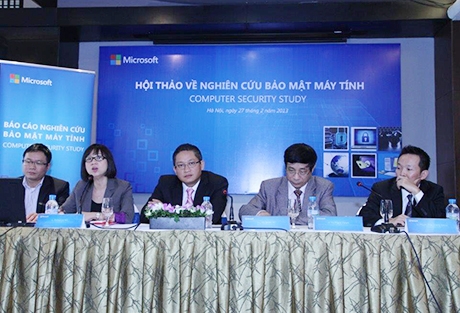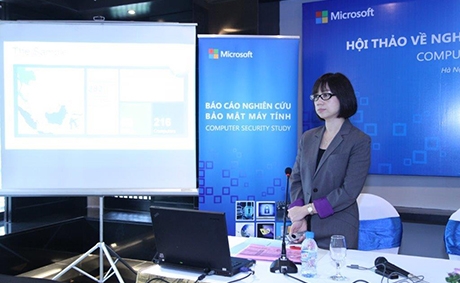Consumers should consider trusted retails

The study, which extends research originally conducted in December 2012, examined 282 computers and DVDs —and found an average malware infection rate of 69 per cent, an increase of six points over the preliminary study. Rebecca Ho, IP strategist of Microsoft in Southeast Asia tells VIR more about the study.
Why did Microsoft undertake this study and why weren’t outside investigators used?
This study was part of routine work we do to monitor the health of our channel. Activities like this are paramount to the protection of Microsoft’s customers and to ensuring a safe digital community.
How many PCs and DVDs were purchased?
Microsoft researchers purchased a total of 282 branded laptop computers and DVDs from PC malls with counterfeit software preinstalled by the distributors containing counterfeit software from Indonesia, Malaysia, the Philippines, Thailand and Vietnam. In Vietnam, the study was done with nine DVDs and 41 computer hard drives.
The sample size seems small. How certain are you that the results reflect the true market situation?

With well over 250+ samples, over 52 branded computers, we’re confident that this is a reliable representation. The expanded study was done in five Southeast Asian countries, showing off the results with 5,601 types of malware, Trojans. Compared with preliminary study of over 100+ samples, with 403 types of malware, trojans we could see that the study had processed deeply in both quantity and quality.
What was the most common type of malware found? What is the danger of using counterfeit software loaded with malware?
On average, 69 per cent of the products inspected were found to contain malware. The most common types were:
• Crackers: programmes that bypasses passwords or licences in computer programmes
• Trojans: applications that appear legitimate and useful but perform malicious and illicit activity on an affected computer; and
• Droppers: types of trojans that drop other files, usually detected as other malware, onto the computer.
Malware loaded onto counterfeit software infects and steals information from a victim’s computer. Cybercriminals are then able to use that information to illegally enter and abuse the victim’s online services, including online bank accounts, email systems and social networking sites.
Cybercriminals can use a victim’s online services to (1) steal from the victim (2) harm the victim’s family, friends, and co-workers through fraudulent emails and social media postings asking for money or distributing more malware and (3) flooding public institution computer networks with Internet traffic causing them to crash.
How does piracy affect Microsoft’s customers?
Every year, millions of consumers and businesses are hurt by counterfeit software which is often acquired unwittingly. In addition, many companies that offer legitimate software have difficulty competing with low prices offered by software pirates. Consumers, businesses and resellers continually ask Microsoft for help mitigate the threats posed by pirates.
Microsoft’s Genuine Software Initiative is advancing education in the software ecosystem about piracy and will continue to invest in engineering technologies to protect its intellectual property, and support enforcement of anti-piracy policies and laws.
What the stars mean:
★ Poor ★ ★ Promising ★★★ Good ★★★★ Very good ★★★★★ Exceptional
Related Contents
Latest News
More News
- First members of Danang International Finance Centre revealed (December 22, 2025 | 17:39)
- Human-centred governance seen as key to AI development (December 19, 2025 | 18:19)
- Top 10 notable events of Vietnam’s industry and trade sector in 2025 (December 19, 2025 | 14:00)
- Tungsten surges to 12-year high as world enters a new 'black gold' race (December 18, 2025 | 17:27)
- Vietnam’s coffee exports set new record despite price pressures (December 18, 2025 | 17:13)
- Garment and textile sector seeks new growth after volatile year (December 18, 2025 | 17:01)
- VinSpeed and Siemens strengthen cooperation for high-speed rail development (December 18, 2025 | 16:53)
- High-tech adoption for TH true MILK (December 18, 2025 | 13:39)
- Takeda supports health resilience amid climate change challenges (December 18, 2025 | 12:39)
- Mondelez Kinh Do - a chapter of purpose-led leadership in Vietnam (December 18, 2025 | 09:44)

 Tag:
Tag:






















 Mobile Version
Mobile Version